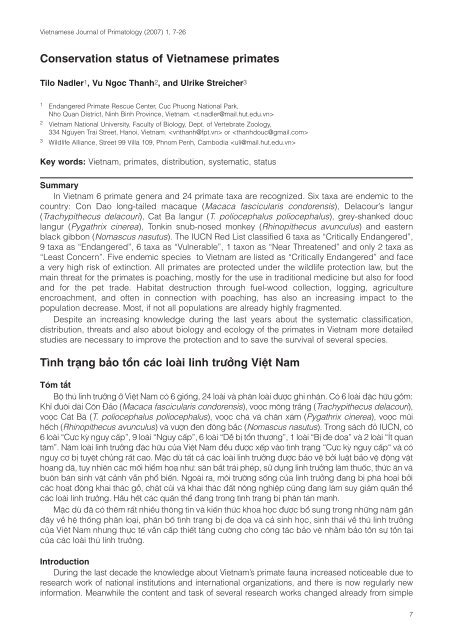Vietnamese Journal of Primatology - Frankfurt Zoological Society
Vietnamese Journal of Primatology - Frankfurt Zoological Society
Vietnamese Journal of Primatology - Frankfurt Zoological Society
You also want an ePaper? Increase the reach of your titles
YUMPU automatically turns print PDFs into web optimized ePapers that Google loves.
<strong>Vietnamese</strong> <strong>Journal</strong> <strong>of</strong> <strong>Primatology</strong> (2007) 1, 7-26<br />
Conservation status <strong>of</strong> <strong>Vietnamese</strong> primates<br />
Tilo Nadler1, Vu Ngoc Thanh2, and Ulrike Streicher3<br />
1 Endangered Primate Rescue Center, Cuc Phuong National Park,<br />
Nho Quan District, Ninh Binh Province, Vietnam. <br />
2 Vietnam National University, Faculty <strong>of</strong> Biology, Dept. <strong>of</strong> Vertebrate Zoology,<br />
334 Nguyen Trai Street, Hanoi, Vietnam. or <br />
3 Wildlife Alliance, Street 99 Villa 109, Phnom Penh, Cambodia <br />
Key words: Vietnam, primates, distribution, systematic, status<br />
Summary<br />
In Vietnam 6 primate genera and 24 primate taxa are recognized. Six taxa are endemic to the<br />
country: Con Dao long-tailed macaque (Macaca fascicularis condorensis), Delacour’s langur<br />
(Trachypithecus delacouri), Cat Ba langur (T. poliocephalus poliocephalus), grey-shanked douc<br />
langur (Pygathrix cinerea), Tonkin snub-nosed monkey (Rhinopithecus avunculus) and eastern<br />
black gibbon (Nomascus nasutus). The IUCN Red List classified 6 taxa as “Critically Endangered”,<br />
9 taxa as “Endangered”, 6 taxa as “Vulnerable”, 1 taxon as “Near Threatened” and only 2 taxa as<br />
“Least Concern”. Five endemic species to Vietnam are listed as “Critically Endangered” and face<br />
a very high risk <strong>of</strong> extinction. All primates are protected under the wildlife protection law, but the<br />
main threat for the primates is poaching, mostly for the use in traditional medicine but also for food<br />
and for the pet trade. Habitat destruction through fuel-wood collection, logging, agriculture<br />
encroachment, and <strong>of</strong>ten in connection with poaching, has also an increasing impact to the<br />
population decrease. Most, if not all populations are already highly fragmented.<br />
Despite an increasing knowledge during the last years about the systematic classification,<br />
distribution, threats and also about biology and ecology <strong>of</strong> the primates in Vietnam more detailed<br />
studies are necessary to improve the protection and to save the survival <strong>of</strong> several species.<br />
T◊nh trπng b∂o tÂn c∏c loµi linh tr≠Îng Vi÷t Nam<br />
T„m tæt<br />
BÈ thÛ linh tr≠Îng Î Vi÷t Nam c„ 6 giËng, 24 loµi vµ ph©n loµi Æ≠Óc ghi nhÀn. C„ 6 loµi Æ∆c h˜u gÂm:<br />
Khÿ Æu´i dµi C´n ß∂o (Macaca fascicularis condorensis), vo‰c m´ng træng (Trachypithecus delacouri),<br />
vo‰c C∏t Bµ (T. poliocephalus poliocephalus), vo‰c chµ v∏ ch©n x∏m (Pygathrix cinerea), vo‰c mÚi<br />
h’ch (Rhinopithecus avunculus) vµ v≠Ón Æen Æ´ng bæc (Nomascus nasutus). Trong s∏ch Æ· IUCN, c„<br />
6 loµi “C˘c k˙ nguy c†p”, 9 loµi “Nguy c†p”, 6 loµi “D‘ bfi tÊn th≠¨ng”, 1 loµi “Bfi Æe doπ” vµ 2 loµi “êt quan<br />
t©m”. N®m loµi linh tr≠Îng Æ∆c h˜u cÒa Vi÷t Nam Æ“u Æ≠Óc x’p vµo t◊nh trπng “C˘c k˙ nguy c†p“ vµ c„<br />
nguy c¨ bfi tuy÷t chÒng r†t cao. M∆c dÔ t†t c∂ c∏c loµi linh tr≠Îng Æ≠Óc b∂o v÷ bÎi luÀt b∂o v÷ ÆÈng vÀt<br />
hoang d∑, tuy nhin c∏c mËi hi”m hoπ nh≠: s®n bæt tr∏i phäp, sˆ dÙng linh tr≠Îng lµm thuËc, th¯c ®n vµ<br />
bu´n b∏n sinh vÀt c∂nh v…n phÊ bi’n. Ngoµi ra, m´i tr≠Íng sËng cÒa linh tr≠Îng Æang bfi ph∏ hoπi bÎi<br />
c∏c hoπt ÆÈng khai th∏c gÁ, ch∆t cÒi vµ khai th∏c Ɔt n´ng nghi÷p cÚng Æang lµm suy gi∂m qu«n th”<br />
c∏c loµi linh tr≠Îng. H«u h’t c∏c qu«n th” Æang trong t◊nh trπng bfi ph©n t∏n mπnh.<br />
M∆c dÔ Æ∑ c„ thm r†t nhi“u th´ng tin vµ ki’n th¯c khoa h‰c Æ≠Óc bÊ sung trong nh˜ng n®m g«n<br />
Æ©y v“ h÷ thËng ph©n loπi, ph©n bË t◊nh trπng bfi Æe d‰a vµ c∂ sinh h‰c, sinh th∏i v“ thÛ linh tr≠Îng<br />
cÒa Vi÷t Nam nh≠ng th˘c t’ v…n c†p thi’t t®ng c≠Íng cho c´ng t∏c b∂o v÷ nhªm b∂o tÂn s˘ tÂn tπi<br />
cÒa c∏c loµi thÛ linh tr≠Îng.<br />
Introduction<br />
During the last decade the knowledge about Vietnam’s primate fauna increased noticeable due to<br />
research work <strong>of</strong> national institutions and international organizations, and there is now regularly new<br />
information. Meanwhile the content and task <strong>of</strong> several research works changed already from simple<br />
7
















